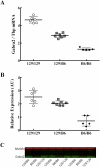Fine Mapping of a Dravet Syndrome Modifier Locus on Mouse Chromosome 5 and Candidate Gene Analysis by RNA-Seq
- PMID: 27768696
- PMCID: PMC5074504
- DOI: 10.1371/journal.pgen.1006398
Fine Mapping of a Dravet Syndrome Modifier Locus on Mouse Chromosome 5 and Candidate Gene Analysis by RNA-Seq
Abstract
A substantial number of mutations have been identified in voltage-gated sodium channel genes that result in various forms of human epilepsy. SCN1A mutations result in a spectrum of severity ranging from mild febrile seizures to Dravet syndrome, an infant-onset epileptic encephalopathy. Dravet syndrome patients experience multiple seizures types that are often refractory to treatment, developmental delays, and elevated risk for SUDEP. The same sodium channel mutation can produce epilepsy phenotypes of varying clinical severity. This suggests that other factors, including genetic, modify the primary mutation and change disease severity. Mouse models provide a useful tool in studying the genetic basis of epilepsy. The mouse strain background can alter phenotype severity, supporting a contribution of genetic modifiers in epilepsy. The Scn1a+/- mouse model has a strain-dependent epilepsy phenotype. Scn1a+/- mice on the 129S6/SvEvTac (129) strain have a normal phenotype and lifespan, while [129xC57BL/6J]F1-Scn1a+/- mice experience spontaneous seizures, hyperthermia-induced seizures and high rates of premature death. We hypothesize the phenotypic differences are due to strain-specific genetic modifiers that influence expressivity of the Scn1a+/- phenotype. Low resolution mapping of Scn1a+/- identified several Dravet syndrome modifier (Dsm) loci responsible for the strain-dependent difference in survival. One locus of interest, Dsm1 located on chromosome 5, was fine mapped to a 9 Mb region using interval specific congenics. RNA-Seq was then utilized to identify candidate modifier genes within this narrowed region. Three genes with significant total gene expression differences between 129S6/SvEvTac and [129xC57BL/6J]F1 were identified, including the GABAA receptor subunit, Gabra2. Further analysis of Gabra2 demonstrated allele-specific expression. Pharmological manipulation by clobazam, a common anticonvulsant with preferential affinity for the GABRA2 receptor, revealed dose-dependent protection against hyperthermia-induced seizures in Scn1a+/- mice. These findings support Gabra2 as a genetic modifier of the Scn1a+/- mouse model of Dravet syndrome.
Conflict of interest statement
The authors have declared that no competing interests exist.
Figures




References
-
- Ogiwara I, Miyamoto H, Morita N, Atapour N, Mazaki E, et al. (2007) Nav1.1 localizes to axons of parvalbumin-positive inhibitory interneurons: a circuit basis for epileptic seizures in mice carrying an Scn1a gene mutation. J Neurosci 27: 5903–5914. 10.1523/JNEUROSCI.5270-06.2007 - DOI - PMC - PubMed
MeSH terms
Substances
Grants and funding
LinkOut - more resources
Full Text Sources
Other Literature Sources
Medical
Molecular Biology Databases
Miscellaneous

